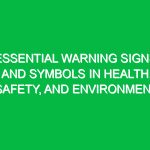Understanding Violence at Work in the HSE Context
Violence at work encompasses a range of behaviors that can cause physical or psychological harm to employees. It includes acts such as bullying, harassment, physical aggression, and even threats of violence. In the Health, Safety, and Environment (HSE) domain, addressing violence at work is crucial not just for compliance with Regulations, but also for fostering a safe and productive workplace. The impact of workplace violence extends beyond the immediate individuals involved; it affects entire teams, organizational culture, and ultimately, the bottom line.
The World Health Organization (WHO) defines workplace violence as any incident where staff are abused, threatened, or assaulted in circumstances related to their work. This definition underscores the necessity for organizations to recognize the potential for violence in various settings, whether in healthcare, education, construction, or corporate environments. The repercussions of ignoring workplace violence can lead to increased absenteeism, decreased morale, and even significant legal liabilities.
The Scope and Impact of Workplace Violence
Understanding the scope of workplace violence is essential for developing effective strategies. According to the U.S. Bureau of Labor Statistics, nearly 2 million workers report having been victims of workplace violence each year. This statistic only scratches the surface, as many incidents go unreported due to fear of retaliation or disbelief that the violence will be taken seriously.
The impact of violence at work is multifaceted:
- Physical Harm: Employees may suffer injuries ranging from minor to severe, and in extreme cases, workplace violence can be fatal.
- Psycho-social Effects: Victims may experience anxiety, depression, and post-traumatic stress disorder (PTSD), which can hinder their ability to perform effectively.
- Organizational Costs: Organizations face increased healthcare costs, legal fees, and a loss of productivity, which can significantly affect their financial health.
- Cultural Implications: Tolerating or ignoring workplace violence can create a toxic culture, leading to high turnover rates and difficulty attracting talent.
In light of these impacts, it becomes imperative for organizations to adopt a proactive stance toward preventing and addressing violence at work.
Key Components of a Violence Prevention Strategy
To effectively confront violence at work, organizations should implement a comprehensive violence prevention strategy. This strategy can be broken down into several key components:
1. Risk Assessment
Conducting a thorough risk assessment is the first step in identifying potential Hazards related to violence at work. This process involves evaluating the physical environment, work processes, and employee interactions. Key factors to consider include:
- Location: Are there areas within the workplace that are isolated or poorly lit?
- Work Patterns: Do specific shifts or job roles experience higher rates of conflict or violence?
- Employee Interactions: Are there known conflicts or tensions among staff members?
By identifying these risks, organizations can develop targeted interventions to reduce the likelihood of violence.
2. Training and Education
Training employees on recognizing and responding to potential violence is crucial. This includes:
- Violence Awareness Training: Employees should be educated about what constitutes workplace violence, how to recognize early warning signs, and the importance of reporting incidents.
- Conflict Resolution Skills: Providing training in de-escalation techniques can empower employees to manage conflicts before they escalate into violence.
- Emergency Response Procedures: All employees should be familiar with the procedures to follow in the event of a violent incident, including evacuation plans and whom to contact for help.
A well-trained workforce is a key line of defense against workplace violence.
3. Policy Development
Organizations should establish clear policies that outline zero tolerance for violence at work. These policies should include:
- Reporting Mechanisms: Clear procedures should be in place for reporting incidents of violence, including options for anonymous reporting.
- Consequences: The policy should detail the consequences for those who engage in violent behavior, ensuring that all employees understand the seriousness of the issue.
- Support for Victims: Policies should also outline the support available for victims of workplace violence, such as counseling services and time off for recovery.
Having a robust policy framework can help create a safe environment where employees feel secure.
4. Continuous Monitoring and Improvement
Workplace violence prevention is not a one-time effort; it requires ongoing evaluation and improvement. Organizations should regularly:
- Review and update violence prevention policies and procedures.
- Solicit feedback from employees about the effectiveness of the current strategies.
- Monitor and analyze incident reports to identify trends and areas for improvement.
By maintaining a dynamic approach to violence prevention, organizations can adapt to changing circumstances and continue to enhance Workplace Safety.
Real-Life Examples of Workplace Violence Strategies
To illustrate the effectiveness of these strategies, let’s look at a few real-life examples:
Case Study: A Healthcare Facility’s Success
In a large urban hospital, staff reported a high incidence of violence from patients and visitors. In response, the administration implemented a comprehensive violence prevention program, including:
- Conducting a risk assessment to identify high-risk areas within the hospital.
- Providing staff with training in conflict resolution and de-escalation techniques.
- Establishing a clear reporting policy and creating a dedicated response team.
As a result of these efforts, the hospital saw a 30% reduction in reported incidents of violence over two years, demonstrating the effectiveness of a proactive approach.
Case Study: Corporate Office Transformation
A corporate office faced issues of bullying and harassment among employees. The company took action by developing a zero-tolerance policy and providing comprehensive training on workplace conduct. They created a safe space for employees to report their experiences without fear of retaliation.
Within six months, employee satisfaction scores increased significantly, showcasing the positive impact of addressing workplace violence head-on.
Regulations and Standards Governing Workplace Violence
In many regions, specific regulations govern the issue of workplace violence. For instance, in the United States, the Occupational Safety and Health Administration (OSHA) provides guidelines that highlight the employer’s responsibility to provide a safe working environment. osha‘s General Duty Clause requires employers to keep their workplaces free from recognized Hazards, including violence.
Additionally, various industries may have specific regulations. For example, healthcare facilities often must adhere to heightened Safety standards due to the nature of their work environments. Understanding and complying with these regulations is crucial for organizations to mitigate risks associated with violence at work.
Conclusion
Confronting violence at work is not merely a regulatory obligation; it is essential for promoting a safe and healthy work environment. By understanding the scope of workplace violence, implementing effective prevention strategies, and complying with relevant regulations, organizations can significantly reduce the risk of violence.
The importance of a proactive approach to violence prevention cannot be overstated. By fostering a culture of Safety and respect, organizations not only protect their employees but also enhance overall productivity and morale. As workplaces continue to evolve, the commitment to addressing violence at work must remain a top priority for all organizations. Taking action today can lead to a safer tomorrow.


